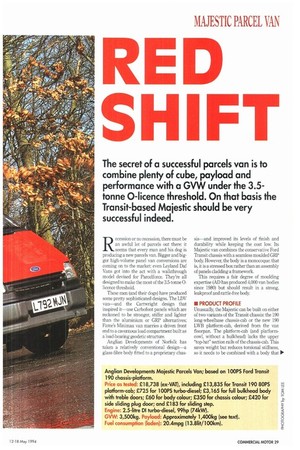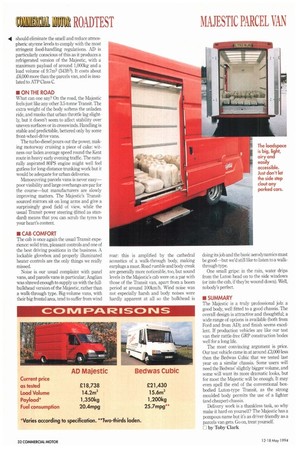The secret of a successful parcels van is to combine
Page 33

Page 34

Page 36

If you've noticed an error in this article please click here to report it so we can fix it.
plenty of cube, payload and performance with a GVW under the 3.5tonne 0-licence threshold. On that basis the Transit-based Majestic should be very successful indeed.
Recession or no recession, there must be an awful lot of parcels out there: it seems that every man and his dog is producing a new parcels van. Bigger and bigger high-volume panel van conversions are coming on to the market even Leyland Daf Vans got into the act with a walktlu-ough model devised for Parcelforce. They're all designed to make the most of the 3.5-tonne 0licence threshold.
These men (and their dogs) have produced some pretty sophisticated designs. The LDV van—and the Cartwright design that inspired it—use Carbofont panels which are reckoned to be stronger, stiffer and lighter than the aluminium or GRP alternatives; Fame's Minimax van marries a driven front end to a cavernous load compartment built as a load-bearing geodetic structure.
Anglian Developments of Norfolk has taken a relatively conventional design—a glass-fibre body fitted to a proprietary chas sis and improved its levels of finish and durability while keeping the cost low Its Majestic van combines the conservative Ford Transit chassis with a seamless moulded GRP body. However, the body is a monocoque: that is, it is a stressed box rather than an assembly of panels cladding a framework.
This requires a fair degree of moulding expertise (AD has produced 4,000 van bodies since 1980) but should result in a strong, leakproof and rattle-free body.
IS PRODUCT PROFILE
Unusually, the Majestic can be built on either of two variants of the Transit chassis: the 190 long-wheelbase chassis-cab or the new 190 LWB platform-cab, derived from the van floorpan. The platform-cab (and platformcowl, without a bulkhead) lacks the upper "top-hat" section rails of the chassis-cab. This saves weight but reduces torsional stiffness, so it needs to be combined with a body that 10.. 410 forms a complete monocoque, such as the GRP Majestic or Bedwas' steel-framed, aluminium-clad Cubic.
The platform-cab is loWer than the chassis-cab, so despite slightly larger interior dimensions it gives 75kg more payload for a given specification. That equates to some 1,425kg in the most basic trim, without a side door or bulkhead and fitted with the standard "80PS" 79hp (59kW) 2.5-litre Ford direct-injection diesel, The platform-cab model is cheaper, too: the body costs 12,955 with a rear roller shutter door and a full bulkhead (12,875 without the bulkhead) as against £3,100 for the chassis-cab body, with its obligatory bulkhead. Add a premium of 11,265 for the chassis-cab itself and the platform-cab looks like a very good idea. Only heavy-duty users, with tail-lifts or cranes, are likely to opt for the chassis-cab.
Our test vehicle was fitted with the "100PS" turbocharged variant of the engine, which puts out 99hp (74kW) and costs £725 more than the naturally aspirated model. We have already assessed this engine in a semihigh-roof Transit van and in the Bedwas Cubic which is in some ways a direct competitor for the Majestic. The turbo-diesel is impressively torquey, but suffers from throttle lag which makes stop-start city driving a pain; we put this down to the engine management system with its electronic "throttle" control. In any case it's ideal for motorway work and reasonably frugal.
The rear load door fitting is a choice between a roller shutter or the treble doors fitted to our test vehicle (at an extra £210). The sliding plug-type side door comes in at £420; a larger hinged side door is £356. Other options include Loadlock strips on the walls (with matching straps) and a sliding step beneath the side door (at £183).
Our vehicle came in a searingly bright red gelcoat finish—photographs hardly do it justice—which costs £60 more than the stan dard Diamond White bodywork. Pigment suppliers Llewellyn Ryland carry 500 stock shades (including metallics) and can match any desired colour.
• PRODUCTIVITY Big volume usually means big frontal area, and big frontal area means big wind resistance; large parcels vans cannot match the fuel consumption figures of conventional vehicles, but aerodynamics are getting better all the time. Our laden figure of 20.4mpg (13.81it./100km) for the Majestic is not brilliant (the semi-high roof Transit managed 25.3mpg) but it was obtained at the excellent average speed of 64.4km/h (40.0mph). The unladen figure was a much better 26.3mpg (10.71it/100km), but here the average speed was held down to 61.6km/h (38.3mph) by heavy traffic. The Bedwas Cubic, with the same engine, came in at 25.7mpg (11.01it/ 100km) around our Kent route but that was with only two-thirds of the available 1,200kg payload; the Majestic was carrying more than 1,300kg. .
Load volume is the main consideration with this type of van, and here Anglian Developments has to give best to Bedwas: the Majestic offers around 500ft3 (14.2m3) corn pared with the ultra-boxy Cubic's 550ft3 (15.6m3). The Majestic has around 65mm more usable headroom in the load compartment, however, though it is 350mm shorter and 130mm narrower inside. It's only fair to point out that the Majestic's load volume is almost twice that of the semi-high roof Transit on the same wheelbase.
Loading is pretty easy whichever door options are chosen: the loading height is 745min unladen, just 25mm more than the conventional van, and shallow wheel boxes protrude from the floor. The chassis-cab version has a completely flat floor, but it's 150mm higher, with a corresponding loss of interior height.
The optional plug-type sliding side door measures 950mm wide by 1,700mm high (much taller than the Transit's standard offering), and a cheaper hinged side door is available which is 1,250mm wide. The sliding outside step seems sturdy enough, though it collects a fair amount of dirt and MUST be retracted properly before setting off—a tamperproof lock would be useful here.
A substantial Luton section is useful for straps and tools but it is too sharply tapered to add much to the useable length of the loadspace. Our test van had a fixed bulkhead; walk-through models are available, opened out, without the shelf.
The treble doors to the rear look fiddly but are versatile and take up little space when open: the middle section hinges round to be clipped to the offside of the van. The hinges and handles are substantial and extremely well finished. Our vehicle also had the useful no-cost option of a translucent roof which lets in quite enough daylight to work by.
The overwhelming smell of moulding resin in the loadspace doubtless diminishes with time, but really was distractingly strong at first. For around £120 Anglian Developments will put the body through a "post-cure" process which entails baking it in an oven for several hours to complete oxidization. This 111.
• should eliminate the smell and reduce atmos
pheric styrene levels to comply with the most stringent food-handling regulations. AD is particularly conscious of this as it produces a refrigerated version of the Majestic, with a maximum payload of around 1,000kg and a load volume of 9.7m3 (343ft3). It costs about .£6,000 more than the parcels van, and is insulated to ATP Class C.
• ON THE ROAD What can one say? On the road, the Majestic feels just like any other 3.5-tonne Transit. The extra weight of the body softens the unladen ride, and masks that urban throttle lag slightly, but it doesn't seem to affect stability over uneven surfaces or in crosswinds. Handling is stable and predictable, bettered only by some front-wheel-drive vans.
The turbo-diesel pours out the power, making motorway cruising a piece of cake: witness our laden average speed round the Kent route in heavy early evening traffic. The naturally aspirated 80PS engine might well feel gutless for long-distance trunking work but it would be adequate for urban deliveries.
Manoeuvring parcels vans is never easy— poor visibility and large overhangs are par for the course—but manufacturers are slowly improving matters. The Majestic's Transitsourced mirrors sit on long arms and give a surprisingly good field of view, while the usual Transit power steering (fitted as standard) means that you can scrub the tyres to your heart's content.
• CAB COMFORT The cab is once again the usual Transit experience: solid trim, pleasant controls and one of the best driving positions in the business. A lockable glovebox and properly illuminated heater controls are the only things we really missed.
Noise is our usual complaint with panel vans, and parcels vans in particular; Anglian was shrewd enough to supply us with the fullbulkhead version of the Majestic, rather than a walk-through type. Big-volume vans, with their big frontal area, tend to suffer from wind roar: this is amplified by the cathedral acoustics of a walk-through body, making earplugs a must. Road rumble and body creak are generally more noticeable, too, but sound levels in the Majestic's cab were on a par with those of the Transit van, apart from a boom period at around 100Iun/h. Wind noise was not especially harsh and body noises were hardly apparent at all so the bulkhead is doing its job and the basic aerodynamics must be good—but we'd still like to listen to a walkthrough type.
One small gripe: in the rain, water drips from the Luton head on to the side windows (or into the cab, if they're wound down). Well, nobody's perfect.
• SUMMARY The Majestic is a truly professional job: a good body, well fitted to a good chassis. The overall design is attractive and thoughtful; a wide range of options is available (both from Ford and from AD); and finish seems excellent. If production vehicles are like our test van their rattle-free GRP construction bodes well for a long life.
The most convincing argument is price. Our test vehicle came in at around £3,000 less than the Bedwas Cubic that we tested last year on a similar chassis. Some users will need the Bedwas' slightly bigger volume, and some will want its more dramatic looks, but for most the Majestic will be enough. It may even spell the end of the conventional boxbodied Luton-type Transit, as the strong moulded body permits the use of a lighter (and cheaper) chassis.
Delivery work is a thankless task, so why make it hard on yourself? The Majestic has a pompous name but it's as driver-friendly as a parcels van gets. Goon, treat yourself.
D by Toby Clark














































































































